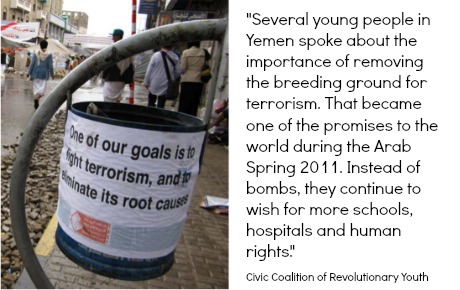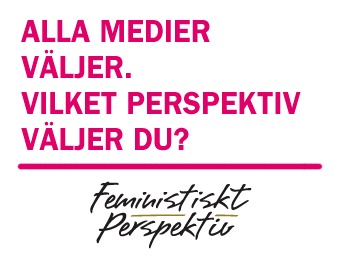
Bild: Tanya Holm
Uncritical coverage of the US drone attacks in Yemen
2014-06-03 | Tanya Holm , översättning Erica Idén Gustafsson

INTERNATIONAL
Tanya Holm has lived in Yemen for four years and has been working as a freelance journalist for Feministiskt Perspektiv, amongst others. For the past months, she has been following the Swedish media coverage of Yemen and reacted to how the US drone attacks have been reported in the daily press. It’s the perspective of the richer country, the strongest men, which is being presented. However, we are not told anything about the women of Yemen.
FACTS WAR AND PEACE JOURNALISM
War journalism is the ruling method of reporting conflicts, according to Galtung, Lynch and McGoldrick, who are behind the concept Peace Journalism. They signify three characteristics: favouring of official spokespeople, focusing on an event and not the process and that two sides are drawn up posited against each other, directed at conflict, instead of the describing the whole picture. Peace Journalism on the other hand is a theory, emerging from peace and conflict studies, which is criticising the idea that journalists are ever neutral and objective conveyors of war and conflict. It is also a work method to report conflicts. In short it means that all parties should be heard, “instead of both sides”, including women. Emotive, demonising words should be avoided and non-violent solutions to conflicts should be emphasised, instead of consistently present violence as necessary.
Peace journalism is often misunderstood; write Lynch and McGoldrick (Peace Journalism, 2005). The name makes some think that it’s about agitating for peace. It is rather that the peace journalist wants to give peace a chance by writing also about non-violent alternative to the conflict that is being covered. The common reporting of war and conflicts is victory oriented and a truce is equated with victory. Peace means in reality the absence of violence. By emphasising peace initiatives and placing focus on structures, culture and society, they want to make the coverage less aggravating, hopeless, more solution oriented and in depth.
Link to Woman to Woman’s publication Peace Journalism
FACTS DRONE ATTACKS IN YEMEN
Confirmed drone attacks: 59-69
Total killed: 287-423
Civilians killed: 24-71
Children killed: 6
Injured: 74-185
Further possible drone attacks: 88-107
Total killed: 306-490
Civilians killed: 23-47
Children killed: 6-8
Injured: 79-112
Other covert operations: 12-77
Total killed: 144-377
Civilians killed: 59-88
Children killed: 24-26
Injured: 22-115
Source: The Bureau of Investigative Journalism
* The Bureau of Investigative Journalism is a London based non-commercial news agency, which works with investigative journalism, and Repriev, an NGO that is working against capital punishment and provides the relatives of those killed in drone attacks with help to get legal redress, are relatively unaccompanied in their ongoing research, but even they meet with difficulties when they try to list the attacks and provide the surrounding world the names of those who are killed.
The article in Swedish
2014-02-07 Okritisk bevakning av USA:s drönarattacker i Jemen
- Write about how Yemen and the US are fighting together against the terrorists!
The foreign editor of a well-renowned North American daily paper called me in Sana’a. This was in 2009, I had just moved to Yemen to work as a freelance journalist. That they were asking me to write made me happy, and then hesitant: what do they mean fighting together?
For the past decade, the US is paying millions in military aid to the, not-yet democratically elected, regime. This provides them with a coalition, allowing the US to conduct military operations in the country. In this way, the US, in their “war on terror”, has been able to conduct attacks without having to announce an actual war; the attacks have instead been operated ‘in cooperation’ and as a part of the ‘military aid’ the US is providing its partner. It was and remains of course a complicated coalition and the editor instructed me on whom I should talk to: the military.
– And an expert who will explain what it’s about.
On top of this, he wanted pictures of Yemeni soldiers training side by side with American soldiers. In Afghanistan and Iraq, the US was considered to have kicked in the door; in Yemen, however, experts said that ‘the door’ had been ‘knocked’. They said that Yemen is a partner, not a target in the “war on terror”. But was the US about to enter Yemen, for real? And was this article, in that case, part of American war propaganda?
The conversation made me uneasy in my role as an independent journalist. Certainly, the paper risked creating, through this kind of bias, a public opinion in the US in support of continuous military efforts in Yemen. It was hard to see how this article could provide the readers with a knowledge basis, allowing them to independently form an opinion regarding this coalition. Also, there was a lack of interest in having me talk to people in the streets and bringing up non-violent ways of working together, despite the fact that the Yemenites had plenty of ideas.
I didn’t like the angle of what was being published in the US, but also in Sweden, where there is a habit of imitating American Yemen-related news; Swedish media didn’t recount how the Yemenites felt about the war, it didn’t say anything about Yemen and was ingratiating towards the US military and secret service. But writing this differently – in practice – was something I had trouble formulating at the time. I understood that the prevalent way of reporting about the country resulted in a misleading, and often also mistaken, portrayal of the situation in Yemen, but I lacked the tools to create other types of news.
At that time, I didn’t know what peace journalism was. Now I’m given Woman to Woman’s recently published brochure, Peace Journalism, which is about a method that wants to change foreign correspondence, make it less violence propagating and aggravating, more comprehensive and nuanced. I wish I had access to this back then, almost five years ago, when I refrained from writing, from fear of not making it into something that was good enough.
I could shortly thereafter confirm that my fears had been justified. The US had just started their drone programme. At first in such secrecy that when the Yemenites talked about the attacks, they were corrected, the news was only allowed to refer to “alleged drone attacks”. The US policy was to never comment on the matter. After two years of various diplomatic leaks, they admitted in 2011 that they have a drone programme and that they really are conducting attacks in Yemen and during last spring Obama finally mentioned a few words regarding this: the drones have “saved human lives” and been both efficient and legal. The programme is still confidential, which makes it particularly difficult for journalists to report about it. What we know is that it regards extrajudicial executions, through unmanned aerial vehicles.
Swedish Yemen coverage
In Sweden, the media coverage on Yemen is so small that one gets the impression that the country almost doesn’t exist. An Egyptian journalist wrote a couple of years back, that if Yemen was to fall into the sea, nobody would notice. The Swedish mass media sometimes express regret over the media shadow covering Yemen, even during the Arab spring, when the country’s enormous protests received some, albeit small, acknowledgement in the daily press. During the past year, however, the coverage appears to have increased compared to last, when barely anything was written on the subject. The focus of the articles has come to be one and the same: the drones.
Last November, when I googled “drones”, “drone attacks” and “Yemen” I got all in all seven articles, spanning a period of more than a year. In the middle of December, another couple of articles were posted after the wedding convoy attack. As many as twenty or so articles were published when the powerless parliament voted no to the drone attacks, a decision that doesn’t change anything for the Yemenites, who are largely controlled by foreign powers. The total amount of articles that Google can find is now 30, and they are rarely different; almost every one of them has listed the news agencies TT and AFP as their sources.
One should think that reasonable news coverage of the attacks would be to provide answers to the five most basic journalistic questions: what, when, where, who and, above all, why. It would place the drone attacks in a context and the reader could find out was has happened, who is involved and why this is happening. Correct media coverage should reasonably also give voice to the Yemenites, not only the Americans. If one looks at all the articles, it is striking how they never manage to fulfil these basic, but important, guidelines.
Why is the US conducting drone attacks?
Not one of these articles is providing an explanation which places the individual attack in a larger war context. In the articles from last month, it is consistently written that the US considers the drones to be “a central part of the fight against terror”. Then, regarding the latest attack, “Last Thursday, 17 people died, mainly civilians, in a drone attack in the central province Bayda, when a wedding convoy was bombed.” After which it was told that “the event triggered outrage and protests in the poor country situated on the southern tip of the Arabian Peninsula.” That the attack is part of the escalation of the US drone war in Yemen is being kept from the reader. The victims are civilians, inhabitants of a country that is struggling with keeping everyone fed and teaching them how to read and write. There is no context and as a reader it is difficult to have an opinion regarding what has happened.
One article states that each attack by the US has been approved by the Yemeni “President Hadi” (elected in an internationally incited one-man election and possible better known as a “transition president” or “temporary leader”). Another article points out that the US has been using drones since 9/11. Yet another concludes that “the terror network al-Qaeda’s branch in Yemen is considered to be the most active and dangerous branch in the whole network”.
One article distinguishes itself by attempting to provide the reader with a context. It starts with “Yemen is in a political limbo”. “Several conflicts are wearing out the country and the instability became clear when drone attacks, a political murder attempt and kidnappings shook the country.” Again, nothing is being said on the ongoing US war and there is no real explanation of what happened. The drone attack is placed within, what appears to be, a chaotic situation and says nothing about, for example, what it is like for the people who live there. That the situation in Yemen is difficult hardly explains why the US is flying in and releasing drones. In that case, a greater part of the world would be in trouble.
Two of the articles are not news articles but editorials and reports. Both are interesting since they are looking to the future. They are anticipating more drone attacks. By looking forward they are explaining, in their own way, why the US is attacking Yemen with drones. In the editorial in UNT they state that “ever since the bloody battles of the ancient world, commanders have been withdrawing from the battlefronts as the technology became more advanced”. The drone will replace conventional air-raids, rockets and long distance robots to a greater extent. The drones’ “precision and flexibility” places them in “the war of the future”.
The journalist behind the report expressed similar notions and referred to a “legendary air force general” who in 1945 “predicted that the wars of the future would be fought by unmanned aerial vehicles”. Straight thereafter, “we haven’t gotten that far yet, but the fact is that already this year there are more pilots – roughly 350 – in the US Air Force being trained to handle unmanned aerial vehicles than there are pilots trained for manned bomb and fighter planes.” Another possible explanation to these attacks thus appears to be the development of the world; the drone is a part of warfare evolution, better suited to current and future conflicts. Why drones? They are better than regular fighter aircrafts!
Swedish news readers could get the impression that this is war propaganda, rather than composed foreign correspondence, which is being spread through the news. This also applies when one is looking for answers to the question of who is being attacked.
The victims are portrayed as suspects
It was Bush who first introduced the “war on terrorism” in 2001 and in the beginning, according to him, it was about a crusade. This was something many Americans disagreed with, so it was soon called an anti-terror war. They used this term, also in Sweden. Our newspapers adopted the American terms (instead of calling it the US Millennia War, New Bush War or today, possibly, the Remote-Controlled US War), and with them, it appears, the bias followed. The consequence is that in the articles I have looked at, they are consistently using the phrases “war on terror” and “fight against terror”. Further terminology is shared with the US military: “terrorist network”, “extremists”, “militant groups” and “counter-terrorism operations”.
In the articles that are reporting about drone attacks, all those who are killed are described as “people”, “civilians” and “persons”. They have, however, in the previous, or following, sentence been connected with “militant groups” or al-Qaeda, alternatively to the war on terror.
At least eight people died during the weekend when the US conducted three attacks via unmanned aerial vehicles, so-called drones, in the Marib province in Yemen. One of the raids was aimed at a vehicle containing four suspected al-Qaeda members, according to witnesses and local sources.
[…] Members of the terrorist network al-Qaeda, amongst others, have exploited the power vacuum in the country and their growing presence is giving cause for worry, not least by the US. During the night between Monday and Tuesday, an unmanned aerial vehicle attacked militant groups and at least 15 people were killed, according to army sources, who claimed the US was responsible.
In an article, relating to a report on drones written by the UN, there is no connection to terror; the attacks are instead said to be a part of the US strategy to fight “militant groups”. This is a more impartial description than “extremists” and “terrorists”. This description, however, does not reveal anything else about those who were attacked, other than that they use weapons. Those exposed to the attacks are not being portrayed anywhere as real people, they are “faithful to al-Qaeda” and “suspected al-Qaeda followers”, but they never act in a human way or provided with a human attribute. They are dead and suspected of being terrorists by the US.
The reader is not given any information that it is only the attackers who have suspected those killed, and that the suspicion stands unchallenged. No Yemenite is given the opportunity to talk about who these people were. And if they actually were part of al-Qaeda, did they belong to the fighting section or did they associate and sympathise with them? Provided that they were part of al-Qaeda, what else can we say about them?
Every now and then it says in the articles that a “source” claims that those killed had been “extremists”. The information is not commented upon. The source is always 1, secret and 2, supporting the US problem formulation; it takes a stand on whether those killed were terrorists and either states they were or that that it is unknown. The source never says anything about civilians or that there is a widespread and well-formulated criticism against the attacks, also within Yemen. There is never a story of a “source” that talks of the victims as “civilians” or “nice people”, someone who used to do homework with the kids in the street.*
The victims’ names were mentioned in only two of the articles. It regarded an older attack. “In the Congress, the [drone] issue has gotten a constitutional dimension, in correlation to the American citizen, Anwar al-Awlaki, having been killed in an attack in Yemen in 2011”. The reader, however, is not told anything about him, more than that he was “born in New Mexico, suspected of being a head-hunter for al-Qaeda in Yemen”. That the US hasn’t presented any evidence is not mentioned, he still remains suspected after his death.
The war has in one of the articles turned people into “targets” and in two instances the murder weapons, via an uncommented quote, became “technological wonders”, or even living creatures: the predator and the Grim Reaper. Yet again, the news is reported using US military terminology. In the example below, a missile is given a name, “Hellfire”, and the everyday life of a drone pilot is described; perhaps in a critical, or perhaps in a humorous manner:
[…] after hours of surveillance, via the drone, which is circling at a height of 7000 metres, of a suspected Afghan terrorist, who might have a family with young children, such as himself. And after eventually, through the help of a Hellfire missile, turning the terrorist into dust – hopefully not having hurt the family in the same blow […]
The agency to describe what is happening in Yemen is something the Swedish media appears to completely hand over to the US. The victims are terrorists, turning into dust and killed by technological wonders. Consistently, they are suspected, extreme and militant. And the attackers, who are they?
Unmanned aerial vehicles and the scared, worried US
Time after another, I need to ask myself whilst reading the articles; which parties are involved, or affected, by the drone attacks. It isn’t being told. Maybe we are expected to know this by now, after twelve and a half year of US military operation. The question is how we are meant to understand this when it is not being told. What is being brought out – as shown above – is that the US have attacked al-Qaeda, extremists, terrorists or militant groups, sometimes only suspects.
In one article an “unmanned aerial vehicle attacked militant groups” after the power vacuum had been causing worry in the US. And “army sources” are claiming that the US is responsible. It’s only being mentioned in two articles that the attacks are not only conducted by American armed forces, but also by their secret service. This has led to criticism within the US and it is told that there is a judicial discussion, regarding the constitution. For example, none of the journalists have spoken to the American peace activists in Code Pink or other anti-war movements, whose critique against the drone attacks regards the people who are dying as a result of them.
Instead, the reader is introduced to, in one of the articles above, Dennis and James (their last names removed for “security reasons”) as well as lieutenant colonel Jeff Patton. Their opinions on the advantages of the drones are being cited. Likewise, it is told what Obama and Brennan, the head for the secret service, have said. The arguments of the attacking party is to an extent being retold, their worries are listed, a few Americans, though only men, speak directly to the readers through quotations. Women are only mentioned in so far as them being wives of the American soldiers. They are waiting at home with their children for the pilots. Women and children in the countries being attacked by the US are not mention, except for the article where the following is being cited. “We can perhaps not see if the target has a moustache or a beard, but you can clearly see if it’s a man or a woman, or a child – in short, who is a friend or an enemy, says squadron leader Dennis.” According to an article, Obama has to show “how the fight against terrorism can be conducted in a defensible way with drones”. War is portrayed through these formulations as a man-against-man thing. Women are nowhere to be seen. Reports about conflicts are to this day maintaining a gender imbalance; women are discriminated against throughout, something which becomes clear when looking at the coverage of the drone attacks. And, of Yemen’s 23 to 27 million inhabitants, only one has been mentioned by name: the temporary leader Hadi. Apart from him there are only anonymous, genderless “witnesses” and “local sources”, which have stated that the drone attacks have been aimed at “suspected members of al-Qaeda”.
The reader is not told anywhere of any information about al-Qaeda apart from the statement that their branch in Yemen is considered the most active. What the group is doing, what it wants and how the average Yemenite relates to the group is not being told.
Not one Yemeni network is mentioned in the articles, not the ones that are creating public opinion against the drone attacks, such as the media collective Support Yemen, and not those that for other reasons have been in the surrounding areas and have a grasp of how the societies are affected. There are within Yemen a few, very controversial voices, who are supporting the drone attacks, but they are not either being cited anywhere in the material.
Violent expectations
In the news articles there is nothing that mentions an alternative to the attacks. No peace movements are being cited, not a single Yemenite is having their argument cited. No journalist in the Swedish press is mentioning another way for the US to take, or another way for the Yemeni regime to relate to the cooperation surrounding the drone programme. I can after studying the articles only draw the following conclusion:
Until the “terrorists” have been bombed to death, the attacks will continue. And an escalation wouldn’t be very surprising. “In the long-term the lawless drone war isn’t favourable to the US security” states the leader. “Particularly in Pakistan and Yemen, where the US alliances have feeble support amongst the population, the anger is growing over the unmanned planes that are shooting against targets in the surrounding areas.” People’s anger over being attacked by the US is here considered a threat against the US security. This correlation is being assumed but to my knowledge it has never been researched.
“In many ways you can say that media today reflects and reproduces society’s power structure, not its composition”, says the peace journalist Jake Lunch in the brochure of Woman to Woman. And if I was to summarise the Swedish coverage of the American drone attacks in Yemen I would say that it reflects the world order. It’s the richer country, the strongest men, who are getting their perspectives cited. We are not told anything about the Yemeni women.
When the daily press starts to also show interest in the Yemenites’ experience and views of the American attacks, only then could we possibly start to understand what it is that the US is doing in Yemen.
Kommentarer
Du måste vara inloggad för att kunna lämna en kommentar.
























MEST KOMMENTERAT
SENASTE KOMMENTARERNA
Om Var Grupp 8 en feministisk organisation?
Om #bildskolan 21: Att äta Den Andre
Om #bildskolan 21: Att äta Den Andre
Om Porr handlar om betalda övergrepp
Om Nobels fredspris till kampanj för att avskaffa kärnvapen
Om Feministiskt perspektiv öppnar arkivet och startar på nytt!
Om Rödgrönt ointresse för fred och nedrustning borde oroa många
Om Var inte målet att vi skulle jobba mindre?
Om Feministiskt perspektiv öppnar arkivet och startar på nytt!
Om Feministiskt perspektiv öppnar arkivet och startar på nytt!
MEST LÄST